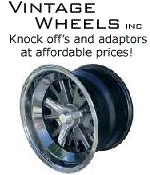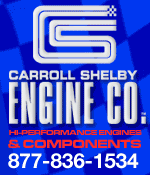 
 Main Menu
Main Menu
|
 Nevada Classics
Nevada Classics
|
 Advertise at CC
Advertise at CC
|
 December 2025
December 2025
|
| S |
M |
T |
W |
T |
F |
S |
| |
1 |
2 |
3 |
4 |
5 |
6 |
| 7 |
8 |
9 |
10 |
11 |
12 |
13 |
| 14 |
15 |
16 |
17 |
18 |
19 |
20 |
| 21 |
22 |
23 |
24 |
25 |
26 |
27 |
| 28 |
29 |
30 |
31 |
|
|
|
|
 CC Advertisers
CC Advertisers
|
|

02-07-2015, 12:02 PM
|
|
CC Member

|
|
|
Join Date: Dec 2014
Cobra Make, Engine: Superformance, Survival Motorsports aluminum FE 482
Posts: 662
|
|

 Not Ranked
Not Ranked
 Air Filter Calculator
Air Filter Calculator
This is interesting, I don't know how accurate it is but it shows for example: a 400HP 427 loses 13hp at 6000 rpm with a 9 x 2 Paper filter.
Second Strike Air Cleaner Calculator
__________________
Bill
|
-
Advertising


02-07-2015, 02:45 PM
|
 |
Senior Club Cobra Member

|
|
|
Join Date: Mar 2000
Location: St. Augustine,
FL
Cobra Make, Engine: E-M / Power Performance / 521 stroker / Holley HP EFI
Posts: 1,943
|
|

 Not Ranked
Not Ranked

Interesting site!
It seems it's a little forgiving (read: not much loss of hp) when I put my info into it, so here's a quote from K&N's web site about filter sizing:
Quote:
Filter Selection
If maximum horsepower is the objective, the size and shape of the air filter element is paramount.
Let's first consider shape. When fitting a conventional round filter on top of the engine, such as a carburetor, central fuel injection or throttle body fuel injection, we have found a large diameter, short filter will flow more air than a small diameter, tall filter. For example, a 10-inch diameter filter 2-inches tall will flow more air than a 5-inch diameter filter that is 4-inches tall. Where space permits, the height of the filter should be between 1/5 and 1/4 of its diameter.
The shape of the filter is less important if the application calls for a remote mounted filter, which includes many late model fuel injected models. Typically these vehicles will use a flat panel filter or a conical or cylindrical shaped filter with a rubber mounting flange designed to be mounted on the end of the inlet hose.
That brings us to size.
Use the formula below to compute the minimum size filter required for your particular application. The usable portion of the filter is called the EFFECTIVE FILTERING AREA which is determined by multiplying the diameter of the filter times Pi (3.1416) times the height of the air filter in inches, then subtracting .75-inch. We subtract .75-inch to compensate for the rubber seals on each end of the element and the filter material near them since very little air flows through this area.
A=(CID X RPM) / 20,839
A = effective filtering area
CID = cubic inch displacement
RPM = revolutions per minute at maximum power
Example: A 350 CID Chevy engine with a horsepower peak at 5,500 rpm.
A=(350 X 5500) / 20,839 = 92.4 square inches
If you are sizing a panel filter, multiply the width of the filter area (not the rubber seal) times its length. If you are sizing a round filter, use the following formula to determine the height of the filter.
H=(A/D*3.14)+0.75
A = effective filtering area
H = height
D = outside diameter of the filter
3.14 = pi
0.75 = the rubber end caps
Example:
H=(92.4 / 12 * 3.14)+0.75 = 3.20 inches
Referencing the K&N catalog shows the proper filter for this application would be an E-1500 which is 3.5 inches tall. Keep in mind, this is the minimum size requirement. To extend the service interval and to provide an even greater volume of air to the engine, install the largest filter that will fit in the space allotted. If the space above the engine is restrictive, perhaps a remote filter arrangement could be used to gain space.
Off-road conditions require added filter area. A filter should be sized 1-1/2 to 2 times larger than normal for any conditions that could be considered severe. In this case, the E-1500 used in our example should be replaced by an E-1120 or an E-1150. For long distance off-road events, two double-size remote mounted filters would be best.
|
If I wasn't quoting I would have made the example a 351 Ford instead...

Tom
__________________
Wells's law of engine size: If it matters what gear you're in, the engine's too small!
|

02-07-2015, 03:58 PM
|
 |
Senior Club Cobra Member

|
|
|
Join Date: Jan 1999
Location: MARKSVILLE,LA.,,
Posts: 3,235
|
|

 Not Ranked
Not Ranked
I'm certainly not an engineer but I know of real world results..
331 stroker,472hp @ 6400 rpms,no air filter
with a 14 inch diameter X 3 inch tall AC Delco paper filter element,my engine lost 2 hp on the dyno.......
The dyno guy was amazed,he guessed it would have been in the 5 to 10 hp range....we did 3 or 4 pulls with the air filter on and just to make sure,it was the same each time.....
David
__________________
DAVID GAGNARD
|

02-07-2015, 04:59 PM
|
 |
CC Member

|
|
|
Join Date: Nov 1999
Location: Brisbane, Australia,
Q
Cobra Make, Engine: Contemporary CCX3117 427FE
Posts: 4,381
|
|

 Not Ranked
Not Ranked
David, it would have been interesting to have then compared a drop base filter assembly or a 2" filter, because the problem is usually that you can't fit a 14x3 in a Cobra like you can in a tintop.
__________________
Craig
|

02-07-2015, 05:52 PM
|
|
CC Member

|
|
|
Join Date: Feb 2003
Location: Jonesboro GA,
Posts: 382
|
|

 Not Ranked
Not Ranked
The K&N calculator shows I need a 14X3.7. When building the intake using the actual media flow numbers it came out to 14x4.1 so not too far off, but still a little happy. I'm running a 14x5 for just a bit of margin.
|

02-07-2015, 07:52 PM
|
 |
CC Member

|
|
|
Join Date: Feb 2014
Location: White City,
SK
Cobra Make, Engine: West Coast, 460 CID
Posts: 2,916
|
|

 Not Ranked
Not Ranked
Quote:
Originally Posted by DAVID GAGNARD

I'm certainly not an engineer but I know of real world results..
331 stroker,472hp @ 6400 rpms,no air filter
with a 14 inch diameter X 3 inch tall AC Delco paper filter element,my engine lost 2 hp on the dyno.......
The dyno guy was amazed,he guessed it would have been in the 5 to 10 hp range....we did 3 or 4 pulls with the air filter on and just to make sure,it was the same each time.....
David
|
If I plug your numbers into the Second Strike Air Cleaner Calculator it returns a 1.99 HP loss @ 6,400 RPM. Pretty close to your 2 HP on the dyno, I'd say.
Change the element to 'oiled felt' (e.g. K&N) and the loss is only 0.68 HP - you could gain a whole 1.31 HP by switching elements. Imagine how much stronger it would pull with an X-Stream top! 
__________________
Brian
|

02-07-2015, 09:14 PM
|
 |
Senior Club Cobra Member

|
|
|
Join Date: Jun 2004
Location: Huntington,
VT
Cobra Make, Engine: E-M 427 Top Oiler stroked to 482 by KC, Stage 2 heads, a Quikfuel and Voila, 640 hp
Posts: 502
|
|

 Not Ranked
Not Ranked
I did this test with an Extreme Top K&N on my 427 before I had it stroked. The difference was...............1 HP less with the air filter in place. The real loss is going from the flywheel to the rear wheels.
Tim
__________________
At first, nothing happened. Then after a few seconds, nothing continued to happen.
Douglas Adams - Hitchhiker's guide to the Galaxy
|

02-07-2015, 11:37 PM
|
 |
CC Member

|
|
|
Join Date: Jan 2009
Cobra Make, Engine: N.A.F., 351 cleveland, 9" ford
Posts: 210
|
|

 Not Ranked
Not Ranked
I agree, filter tops are going to get more air in than a solid top. Just common sense, no calculator, more surface area = more air flow. Just have to get use to the look.
Paul...
|

02-08-2015, 06:17 AM
|
 |
Senior Club Cobra Member

|
|
|
Join Date: Jan 1999
Location: MARKSVILLE,LA.,,
Posts: 3,235
|
|

 Not Ranked
Not Ranked
Quote:
Originally Posted by 750hp

David, it would have been interesting to have then compared a drop base filter assembly or a 2" filter, because the problem is usually that you can't fit a 14x3 in a Cobra like you can in a tintop.
|
This engine went into my 1965 Mustang Coupe road racer,same one in my avatar.......
The air filter housing actually was a drop based filter...on the Mustang,you can run a 2" filter and it will fit under the stock hood,barely.......I wanted at least a 3" filter,so I had got a drop base filter housing of 1.5"s and that is what was used on the dyno and the car.....
David
__________________
DAVID GAGNARD
|

02-08-2015, 06:56 AM
|
 |
Senior Club Cobra Member

|
|
|
Join Date: May 2001
Location: Florence,
AL
Cobra Make, Engine: RCR GT 40 & 1966 Fairlane 390 5 speed
Posts: 4,511
|
|

 Not Ranked
Not Ranked
 air filter
air filter
three years ago I was working on a B&B with a stock-ist 351W. We took it to the industrial park and ran it thru the gears. It would not rev pass 4300 rpms in any gear.
We pulled over to the side of the road and looked under the hood. It had a 8" S&H filter . We removed the air cleaner/filter. Now it would pull to 6,000 with no problem.
The air filter was clean.
We bought a larger filter and problem solved.
Dwight
I put the 8" filter on my old 79 Ford truck with a 302. It could not rev to 4000 before the filter, so the filter can hurt it. LOOK good on motor.
__________________
''Life's tough.....it's even tougher if you're stupid.'' ~ John Wayne
"Happiness Is A Belt-Fed Weapon"
life's goal should be; "to be smarter than inanimate objects"
|

03-01-2015, 05:20 PM
|
 |
CC Member/Contributor

|

|
|
Join Date: Mar 2012
Posts: 445
|
|

 Not Ranked
Not Ranked
Back to back dyno pulls, using the tiny K&N filter on my 351w 427, it went from 461rwhp with the filter to 482rwhp at 5600 with no filter.
Last edited by itstock; 03-01-2015 at 05:30 PM..
|

03-02-2015, 06:09 AM
|
 |
Member of the north

|
|
|
Join Date: May 2003
Cobra Make, Engine: A Cobra
Posts: 11,207
|
|

 Not Ranked
Not Ranked
I did my own calculations.
(( CID x Max RPM ) / 3456 ) * 1.1 = CFM...I use this for the cubic feet.
Then the square area of the filter AND the filter level.
If your filter is very fine, like 5 microns, you are going to need a larger area to allow the same amount of air to flow through.
Then there is the accumulated time to a reduction in flow. If you use an area that equals your calculation, you are going to be at a loss as soon as you pull in air and filter it.
Not sure if this hellps anyone, but it is interesting when you are thinking of putting in cold air intake system.

__________________
I'm a writer, feed the artist and buy a book.
|

03-02-2015, 07:08 AM
|
|
CC Member

|
|
|
Join Date: Feb 2003
Location: Jonesboro GA,
Posts: 382
|
|

 Not Ranked
Not Ranked

Quote:
Originally Posted by trularin

I did my own calculations.
(( CID x Max RPM ) / 3456 ) * 1.1 = CFM...I use this for the cubic feet.
Then the square area of the filter AND the filter level.
If your filter is very fine, like 5 microns, you are going to need a larger area to allow the same amount of air to flow through.
Then there is the accumulated time to a reduction in flow. If you use an area that equals your calculation, you are going to be at a loss as soon as you pull in air and filter it.
Not sure if this hellps anyone, but it is interesting when you are thinking of putting in cold air intake system.
 |
I think level of filtration and filter area is where the calculators have issues. One 14X4 may have double the effective filter area when compared to another one of the same size. If you don't know the media flow characteristics new vs. after some use, the calculators are only valuable for new filters.
All of this is why I am of the belief that most cobra owners are losing much more to filtration than they would like to believe. I would love to have gone with a 14X4 but the math clearly supported the need for 14X5 for a 700 hp engine.

|
 Posting Rules
Posting Rules
|
You may not post new threads
You may not post replies
You may not post attachments
You may not edit your posts
HTML code is Off
|
|
|
All times are GMT -7. The time now is 06:23 PM.
|






















 Linear Mode
Linear Mode



